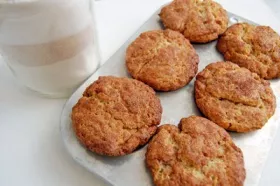Here are a couple of recipes that go well with a cup (or two) of your favorite coffee.
Key to abbreviations: c. = cup • oz. = ounce • tsp. = teaspoon • Tbsp. = tablespoon • lb. = pounds • g = grams • mg = milligrams
Snickerdoodle Muffins
1 c. (2 sticks) margarine
1¼ c. Greek yogurt (plain, nonfat)
2 eggs
2 tsp. vanilla extract
1 c. sugar
¾ tsp. baking soda
¾ tsp. baking powder
¾ tsp. cream of tartar
¾ tsp. ground nutmeg
½ tsp. ground cinnamon
1½ c. all-purpose white flour
¾ c. whole-wheat flour
Topping: 5 tsp. sugar plus 1 tsp. ground cinnamon
1. Preheat oven to 350 F.
2. Combine wet ingredients (margarine, Greek yogurt, eggs and vanilla) in one bowl.
3. Combine dry ingredients (sugar, baking soda, baking powder, cream of tartar, ground nutmeg, ground cinnamon, all-purpose white flour and whole-wheat flour) in a separate bowl.
4. Fold the dry ingredients into the wet ingredients until dry ingredients are well-mixed. Make sure not to overmix muffins; lumpy batter is OK.
5. Grease muffin tins or use paper liners.
6. Scoop muffin batter into muffin tins to make about 22 muffins.
7. Stir together additional sugar and cinnamon and sprinkle a portion on each muffin.
8. Bake for 20 to 22 minutes or until they are golden brown.
Makes approximately 22 servings. Each serving has 180 calories, 9 g fat, 3 g protein, 23 g carbohydrate, 1 g fiber and 130 mg sodium.
Blueberry and Oatmeal Power Muffins
2 c. all-purpose flour
1 c. oats, quick or regular
⅔ c. sugar
1 tsp. baking powder
1 tsp. baking soda
½ tsp. salt
1½ c. honey nonfat Greek yogurt
2 large eggs, lightly beaten
4 Tbsp. unsalted butter, melted and slightly cooled
1 tsp. vanilla extract
1 c. fresh blueberries
1. Heat oven to 350 F.
2. Coat muffin tin with cooking spray or liners.
3. Combine flour, oats, sugar, baking powder, baking soda and salt in a bowl.
4. Combine yogurt, eggs, butter and vanilla in a second bowl.
5. Fold yogurt mixture into dry mixture; stir to combine completely.
6. Gently fold in blueberries.
7. Spoon into muffin tins.
8. Bake until top is golden and a toothpick inserted in center comes out clean, approximately 20 to 25 minutes.
Makes 16 servings. Each serving has 170 calories, 4.5 g fat, 4 g protein, 29 g carbohydrate, 1 g fiber and 210 mg sodium.
NDSU Extension does not endorse commercial products or companies even though reference may be made to tradenames, trademarks or service names. NDSU encourages you to use and share this content, but please do so under the conditions of our Creative Commons license. You may copy, distribute, transmit and adapt this work as long as you give full attribution, don’t use the work for commercial purposes and share your resulting work similarly. For more information, visit www.ag.ndsu.edu/agcomm/creative-commons.
For more information on this and other topics, see www.ag.ndsu.edu/food
County commissions, North Dakota State University and U.S. Department of Agriculture cooperating. NDSU does not discriminate in its programs and activities on the basis of age, color, gender expression/identity, genetic information, marital status, national origin, participation in lawful off-campus activity, physical or mental disability, pregnancy, public assistance status, race, religion, sex, sexual orientation, spousal relationship to current employee, or veteran status, as applicable. Direct inquiries to Vice Provost for Title IX/ADA Coordinator, Old Main 201, NDSU Main Campus, 701-231-7708, ndsu.eoaa@ndsu.edu. This publication will be made available in alternative formats for people with disabilities upon request, 701-231-7881. web-7-18; web-5-23



